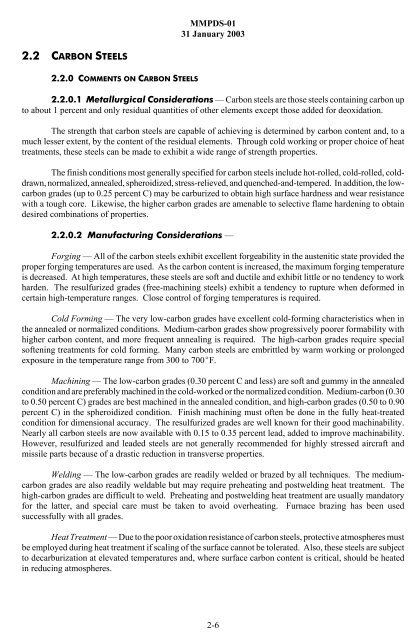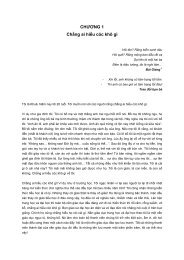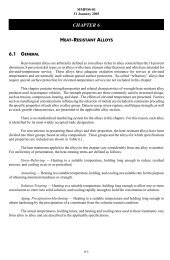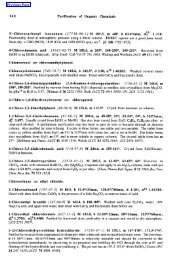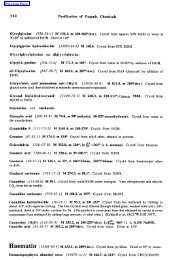steel - Nouvelle page 1 - Free
steel - Nouvelle page 1 - Free
steel - Nouvelle page 1 - Free
You also want an ePaper? Increase the reach of your titles
YUMPU automatically turns print PDFs into web optimized ePapers that Google loves.
MMPDS-01<br />
31 January 2003<br />
2.2 CARBON STEELS<br />
2.2.0 COMMENTS ON CARBON STEELS<br />
2.2.0.1 Metallurgical Considerations — Carbon <strong>steel</strong>s are those <strong>steel</strong>s containing carbon up<br />
to about 1 percent and only residual quantities of other elements except those added for deoxidation.<br />
The strength that carbon <strong>steel</strong>s are capable of achieving is determined by carbon content and, to a<br />
much lesser extent, by the content of the residual elements. Through cold working or proper choice of heat<br />
treatments, these <strong>steel</strong>s can be made to exhibit a wide range of strength properties.<br />
The finish conditions most generally specified for carbon <strong>steel</strong>s include hot-rolled, cold-rolled, colddrawn,<br />
normalized, annealed, spheroidized, stress-relieved, and quenched-and-tempered. In addition, the lowcarbon<br />
grades (up to 0.25 percent C) may be carburized to obtain high surface hardness and wear resistance<br />
with a tough core. Likewise, the higher carbon grades are amenable to selective flame hardening to obtain<br />
desired combinations of properties.<br />
2.2.0.2 Manufacturing Considerations —<br />
Forging — All of the carbon <strong>steel</strong>s exhibit excellent forgeability in the austenitic state provided the<br />
proper forging temperatures are used. As the carbon content is increased, the maximum forging temperature<br />
is decreased. At high temperatures, these <strong>steel</strong>s are soft and ductile and exhibit little or no tendency to work<br />
harden. The resulfurized grades (free-machining <strong>steel</strong>s) exhibit a tendency to rupture when deformed in<br />
certain high-temperature ranges. Close control of forging temperatures is required.<br />
Cold Forming — The very low-carbon grades have excellent cold-forming characteristics when in<br />
the annealed or normalized conditions. Medium-carbon grades show progressively poorer formability with<br />
higher carbon content, and more frequent annealing is required. The high-carbon grades require special<br />
softening treatments for cold forming. Many carbon <strong>steel</strong>s are embrittled by warm working or prolonged<br />
exposure in the temperature range from 300 to 700EF.<br />
Machining — The low-carbon grades (0.30 percent C and less) are soft and gummy in the annealed<br />
condition and are preferably machined in the cold-worked or the normalized condition. Medium-carbon (0.30<br />
to 0.50 percent C) grades are best machined in the annealed condition, and high-carbon grades (0.50 to 0.90<br />
percent C) in the spheroidized condition. Finish machining must often be done in the fully heat-treated<br />
condition for dimensional accuracy. The resulfurized grades are well known for their good machinability.<br />
Nearly all carbon <strong>steel</strong>s are now available with 0.15 to 0.35 percent lead, added to improve machinability.<br />
However, resulfurized and leaded <strong>steel</strong>s are not generally recommended for highly stressed aircraft and<br />
missile parts because of a drastic reduction in transverse properties.<br />
Welding — The low-carbon grades are readily welded or brazed by all techniques. The mediumcarbon<br />
grades are also readily weldable but may require preheating and postwelding heat treatment. The<br />
high-carbon grades are difficult to weld. Preheating and postwelding heat treatment are usually mandatory<br />
for the latter, and special care must be taken to avoid overheating. Furnace brazing has been used<br />
successfully with all grades.<br />
Heat Treatment — Due to the poor oxidation resistance of carbon <strong>steel</strong>s, protective atmospheres must<br />
be employed during heat treatment if scaling of the surface cannot be tolerated. Also, these <strong>steel</strong>s are subject<br />
to decarburization at elevated temperatures and, where surface carbon content is critical, should be heated<br />
in reducing atmospheres.<br />
2-6


